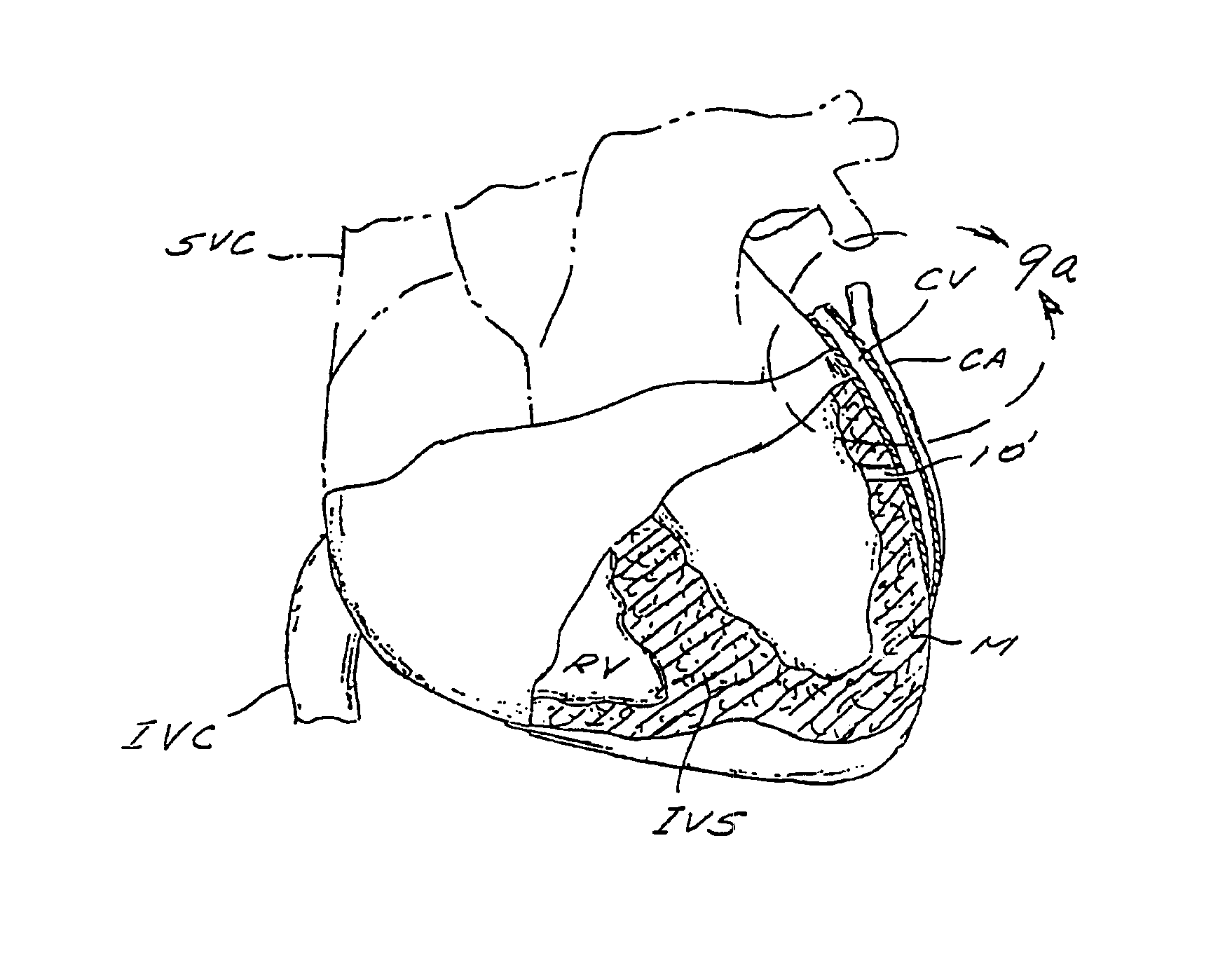Method and apparatus for transmyocardial direct coronary revascularization
a direct coronary revascularization and transmyocardial technology, applied in the field of medical treatment methods and devices, can solve the problems of inability to perform coronary artery bypass surgery, and inability to achieve direct blood flow, etc., to achieve the effect of facilitating valving or direct blood flow
- Summary
- Abstract
- Description
- Claims
- Application Information
AI Technical Summary
Benefits of technology
Problems solved by technology
Method used
Image
Examples
first embodiment
[0065]FIGS. 2, 2a and 2b show a first embodiment of an intravascular valving apparatus 20 which is positioned within the lumen of a coronary blood vessel CBV (artery, vein or man-made passageway), at a location which is adjacent it's intersection with the transmyocardial passageway 10. This embodiment of the valving apparatus 20 has a cylindrical body having an axial bore 24 which extends longitudinally therethrough, and a side aperture 22 formed in the sidewall thereof. The side aperture 22 is preferably the same size or larger than the diameter of the adjacent end of the transmyocardial passageway 10, such that blood flowing from the cardiac chamber (e.g., left ventricle LV) through the transmyocardial passageway 10 will pass directly through the side aperture 22 and into the bore 24 of the valving apparatus 20. An occluder member 26, such as a hinged obturator or pliable elastomeric leaflet is affixed to the cylindrical body of the valving apparatus 20, and extends over and subst...
second embodiment
[0068]FIG. 3 shows a second embodiment of the intravascular valving apparatus 30 which comprises a generally cylindrical body having an axial bore 34 extending longitudinally therethrough and a pair of occluder members 46 positioned therewithin, and a side aperture 32: formed in the cylindrical sidewall of the apparatus 30, behind the occluder members 36. Each occluder member 36 is affixed at least one point to the cylindrical body of the apparatus 30, and may comprise any suitable structure or openable and closeable passage, such as a self-sealing slit or hole, or a hinged leaflet or pliable elastomeric member. The occluder members 46 are alternately moveable between first positions wherein the occluder members 36 directly contact one another so as to prevent blood from backflowing in the backflow direction BD through the axial bore 34 of the apparatus 30, and second positions wherein the occluder members 36 move out of contact with one another such that blood may flow through the ...
third embodiment
[0073]FIG. 4 shows a third embodiment of the intravascular valving apparatus 40 which comprises a generally cylindrical body having an axial bore 42 extending longitudinally therethrough and a plurality of occluder members 46 formed therewithin. The cylindrical body and occluder members 46 of this third embodiment of the apparatus 40 are the same as those of the above described second embodiment, except that the cylindrical body of this third embodiment is devoid of any side aperture(s) or openings in the cylindrical sidewall. In contrast to the above described second embodiment 30, this third embodiment of the apparatus 40 is implanted in the lumen of the coronary blood vessel CBV at a location which is downstream of the junction between the coronary blood vessel CBV and the first bloodflow passageway 10.
[0074]It will be appreciated that the individual features and attributes of each of the above-described embodiments of valving apparatus 20, 30, 31, 33, 40 may be incorporated into...
PUM
| Property | Measurement | Unit |
|---|---|---|
| pressure | aaaaa | aaaaa |
| elastic | aaaaa | aaaaa |
| flexible | aaaaa | aaaaa |
Abstract
Description
Claims
Application Information
 Login to View More
Login to View More - R&D
- Intellectual Property
- Life Sciences
- Materials
- Tech Scout
- Unparalleled Data Quality
- Higher Quality Content
- 60% Fewer Hallucinations
Browse by: Latest US Patents, China's latest patents, Technical Efficacy Thesaurus, Application Domain, Technology Topic, Popular Technical Reports.
© 2025 PatSnap. All rights reserved.Legal|Privacy policy|Modern Slavery Act Transparency Statement|Sitemap|About US| Contact US: help@patsnap.com



